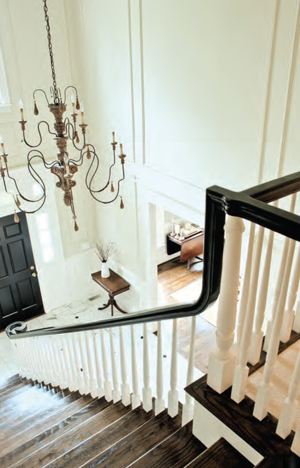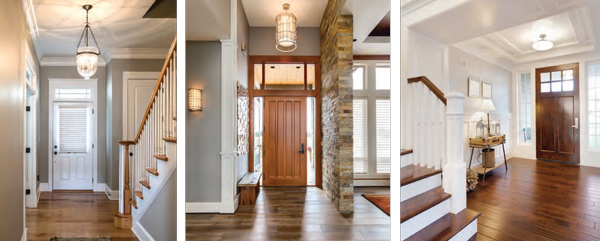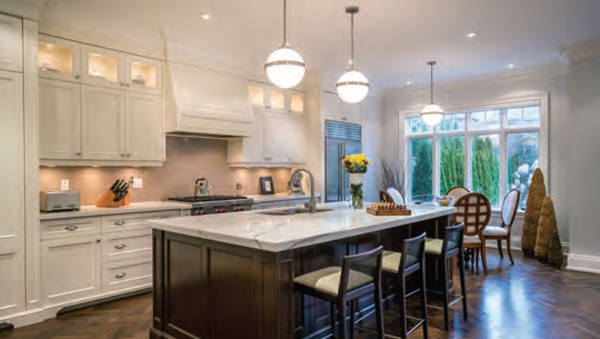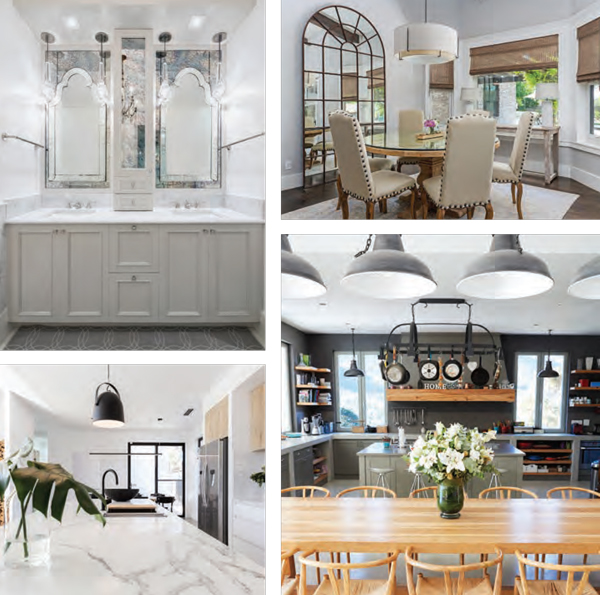Lighting 101 | Specs to Help Illuminate Your Space

There’s plenty of good news when it comes to lighting the interior of your home: options are abundant, instructions—in some cases, formulas—are available, and, best of all, you make the decisions.
“We tell our customers that we provide guidelines,” says Kate Farmer of Sweet Peas Lighting and Decor in Gretna. “At the end of the day, your home has to make you happy.”
As owners of a residential construction company, Farmer and her husband, Ben, often helped homeowners with lighting selections. After a client observed that she wasn’t thrilled to spend $4,000 on a fixture without being able to see it in person, an idea was born.
The couple bought a building that had been a lighting store years before, which helped foster relationships with lighting manufacturers that have seen brick-and-mortar lighting stores close, under pressure from online sales. Now, Farmer says, customers again have the chance to see, up close, different finishes and configurations, as well as evaluate quality of craftsmanship.
“The market is so large, and the possibilities are just endless,” she notes. “You can’t get a really good feel for what you’re buying when you’re online.”
Farmer has an information sheet she gives clients to help guide the lighting process. She also advises people to find pictures of what they like, whether in magazines or online. Common pitfalls to avoid include selecting fixtures that are too small for the space, hanging lights too high, and using inexpensive LED bulbs that, yes, will burn out earlier than they should.
Specs to consider
Here are some general guidelines to get you started when lighting your home.
Throughout the house, pay attention to ceiling height. Eight feet is standard, but some may be taller. Make sure overhead lights are no less than 7 feet from the floor. For two-story spaces, hang fixtures so the bottom is level with where the first-floor ceiling would be.
In a foyer or entryway that’s not vaulted, look for a flush mount or semi-flush, where the fixture extends no more than 6 to 8 inches from the ceiling. These low-profile fixtures are also suitable for closets, utility rooms and smaller bathrooms.
For an overhead fixture in the living room, the larger the room, the larger the light. To determine size, add the length and width of the room. The total represents the size, in inches, that the fixture should be. For example, for a room that’s 14 feet by 16 feet, consider a fixture that’s 30 inches in diameter. For the height of the fixture, measure the ceiling height and multiply by 2.5 and 3. The resulting number, in inches, is the suggested range for height. For example, a 9-foot ceiling would call for a fixture that’s 22.5 inches to 27 inches tall.
Recessed or can lights should be placed starting in the center of the room, with an equal distance between them. The distance should be half the ceiling height, so a room with an 8-foot ceiling should have can lights placed 4 feet apart. Keep lights 3 feet away from walls.
Wall sconces should be placed no lower than 5 feet from the floor, 4 to 6 feet apart, unless they are being used to highlight a specific area, such as furniture or a fireplace.
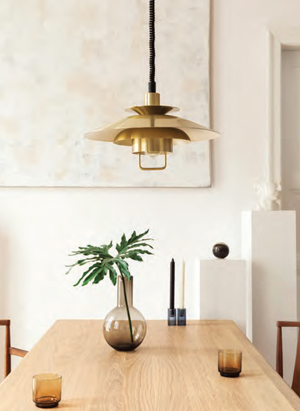 In the dining room, the table being lit helps determine the size of the fixture. Select one that will hang 28 to 36 inches above the table and will be 6 inches from every edge. If the table is rectangular or oval, a linear design works best, to evenly light the full surface. If the table is square or round, a chandelier or pendant works well.
In the dining room, the table being lit helps determine the size of the fixture. Select one that will hang 28 to 36 inches above the table and will be 6 inches from every edge. If the table is rectangular or oval, a linear design works best, to evenly light the full surface. If the table is square or round, a chandelier or pendant works well.
With all the work that happens in the kitchen, good lighting is essential. Pendants should be hung over islands or countertops so they are 28 to 34 inches from the working surface. Lights should be placed so they aren’t in the way of the person standing at the counter. If you have a tall family, hang the lights higher!
Two or three pendants over a counter are best, to avoid visual clutter. To determine placement over a workspace that doesn’t have a sink or stovetop, measure the length of the counter. If hanging two pendants, divide that length by 3, then hang each pendant that distance from the opposite edges. If hanging three pendants, center the first pendant at the midpoint, then hang each other equidistant from the center light to the edge. Again, make sure there’s at least 6 inches between the light and the edge of the counter.
Most bathroom lighting is found alongside or above the mirror. If possible, vertical lights are preferable, because they provide even facial lighting. Side sconces should be 18 inches tall (or 12 inches, for small powder rooms). The center of the fixture should be at eye level. For lights above a mirror, select a fixture that is roughly 75 percent the width of the mirror.
Fancy chandeliers in the bathroom are fun, but need to be hung 8 feet above the top of the tub and 3 feet away from the edge, to prevent injury.
Remember, Farmer says, lighting should reflect the homeowner. “In my mind, lighting is an accessory, like jewelry,” she adds. “If it makes you happy, you’re the only one who has to be happy about it.” ✦
bathroom lighting, ceiling height, closets, design, dining room, flush mount, hanging lights, lighting, lighting selections, low-profile fixtures, overhead lights, Pendants, Recessed or can lights, semi-flush, two-story spaces, utility rooms, Wall Sconces

